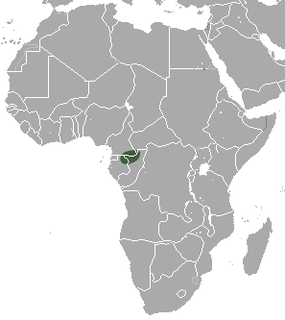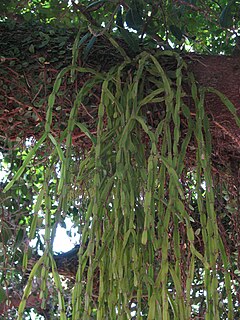
Rhipsalis baccifera, commonly known as the mistletoe cactus, is an epiphytic cactus which originates from Central and South America, the Caribbean, and Florida. It is also found throughout the tropics of Africa and into Sri Lanka where it is known in Sinhala as nawahandi (නවහන්දි). This is the only cactus species naturally occurring outside the Americas. One hypothesis is that it was introduced to the Old World by migratory birds, long enough ago for the Old World populations to be regarded as distinct subspecies. An alternative hypothesis holds that the species initially crossed the Atlantic Ocean on European ships trading between South America and Africa, after which birds may have spread it more widely.
Daniellia oblonga is a species of plant in the family Fabaceae. It is found in Benin, Cameroon, Equatorial Guinea, and Nigeria. It is threatened by habitat loss.

Callitris oblonga, also called South Esk pine, pigmy cypress pine, river pine, or Tasmanian cypress pine, is a species of conifer in the family Cupressaceae. It is endemic to Australia, and is threatened by habitat loss.
Sterculia oblonga, the yellow sterculia, is a commercial timber tree in the family Malvaceae. It is native to the tropical rainforests of Cameroon, Ivory Coast, Equatorial Guinea, Gabon, Ghana, Liberia, Nigeria, and Sierra Leone. It is threatened by habitat loss.

The northern snake-necked turtle is a species of turtle in the family Chelidae or Austro-South American Side-necked Turtles. It is native to northern Australia and southern New Guinea.

Flower's shrew is a species of mammal in the family Soricidae. It is endemic to Egypt. Its natural habitat is arable land. It is threatened by habitat loss.

The Usambara shrew is a species of mammal in the family Soricidae. It is endemic to Tanzania. Its natural habitat is subtropical or tropical moist montane forests. It is threatened by habitat loss.

Remy's pygmy shrew is a species of mammal in the family Soricidae. It is found in Cameroon, the Central African Republic, the Republic of the Congo, and Gabon. Its natural habitat is subtropical or tropical moist lowland forests. It is threatened by habitat loss.
Helicia albiflora is a species of plant in the family Proteaceae. It is endemic to Papua New Guinea. It is threatened by habitat loss.
Rhipsalis cereoides is a species of plant in the family Cactaceae. It is endemic to Brazil. Its natural habitats are subtropical or tropical moist lowland forests and rocky areas. It is threatened by habitat loss.

Rhipsalis crispata is a species of terrestrial plant in the family Cactaceae.

Rhipsalis elliptica is a species of plant in the family Cactaceae. It is endemic to Brazil. Its natural habitat is subtropical or tropical moist lowland forest. It is threatened by habitat loss.

Rhipsalis floccosa is a species of plant in the family Cactaceae. It is found in Argentina, Bolivia, Brazil, Paraguay, Peru, and Venezuela. Its natural habitat is subtropical or tropical moist lowland forest. It is threatened by habitat loss.

Rhipsalis hoelleri is a species of plant in the family Cactaceae. It is endemic to Brazil. Its natural habitat is subtropical or tropical moist lowland forests. It is threatened by habitat loss.
Rhipsalis pacheco-leonis is a species of plant in the family Cactaceae. It is endemic to Brazil. Its natural habitats are subtropical or tropical moist lowland forests and rocky areas. It is threatened by habitat loss. It needs water and sunlight.

Rhipsalis paradoxa is a species of plant in the family Cactaceae. It is endemic to Brazil. Its natural habitat is subtropical or tropical moist lowland forests. It is threatened by habitat loss.

Rhipsalis pilocarpa, the hairy-fruited wickerware cactus, is a species of flowering plant in the cactus family that is endemic to Brazil. Scarce in the wild, it is known only in a small number of isolated locations. Its status is listed as “vulnerable” by the IUCN Red List. However, it is cultivated as an ornamental houseplant and as such has gained the Royal Horticultural Society’s Award of Garden Merit.

Rhipsalis russellii is a species of plant in the family Cactaceae. It is endemic to Brazil. Its natural habitats are subtropical or tropical moist lowland forests and rocky areas. It is threatened by habitat loss.

Rhipsalis sulcata is a species of plant in the genus Rhipsalis and family Cactaceae. It is endemic to Brazil. Its natural habitats are subtropical or tropical moist lowland forests and rocky areas. It is threatened by habitat loss.

Rhipsalis mesembryanthemoides is a cactus in the genus Rhipsalis of the family Cactaceae. The first description was in 1821 by Adrian Hardy Haworth. The shoots are reminiscent of the plants of the genus Mesembryanthemum, hence the epithet mesembryanthemoides.
















